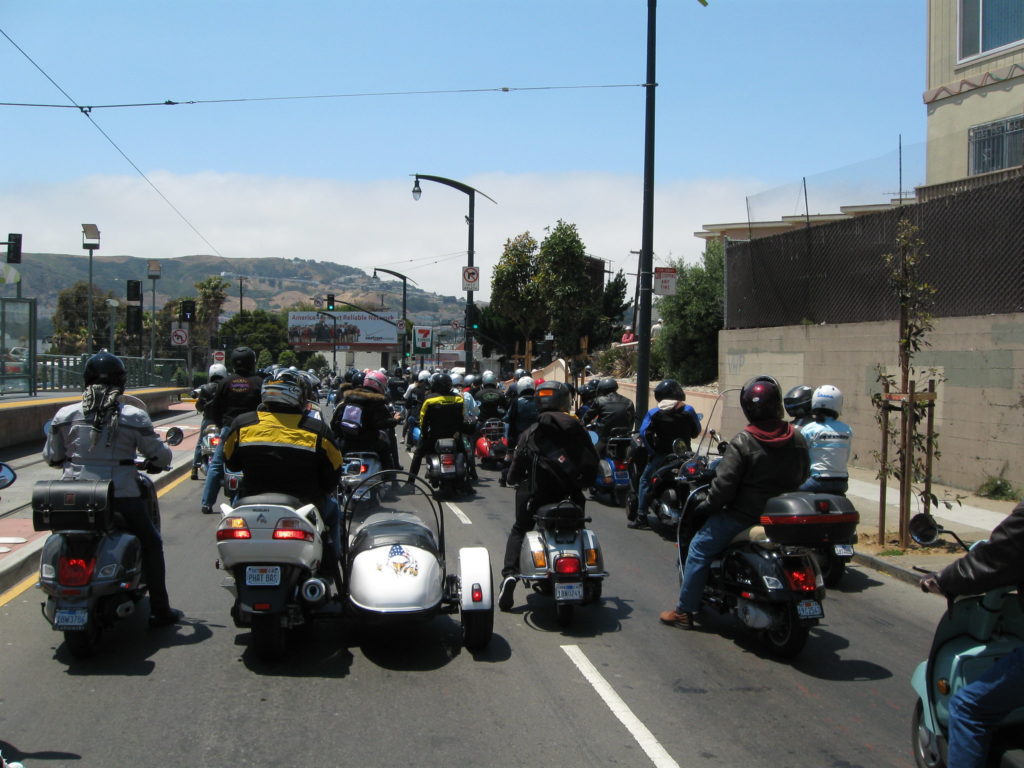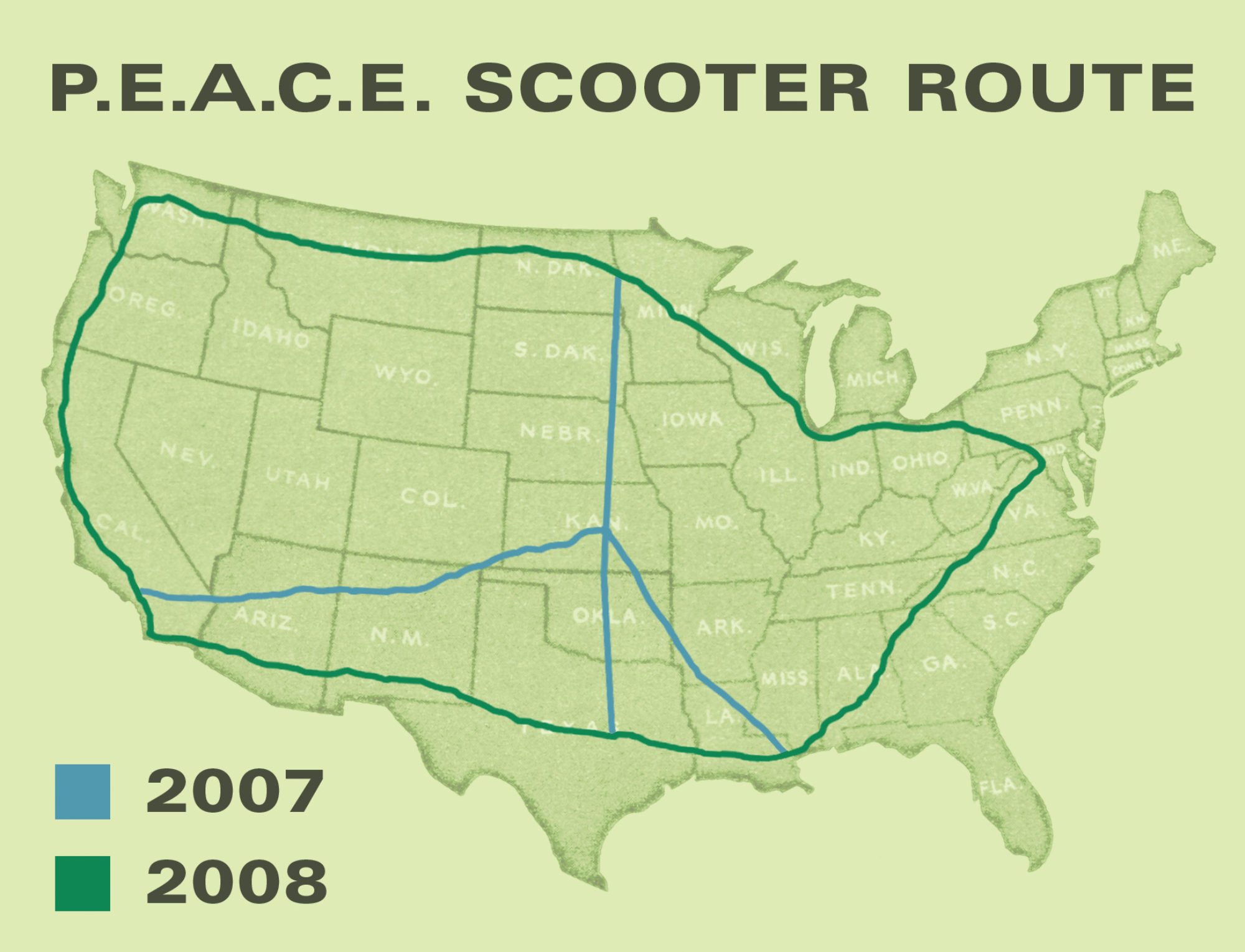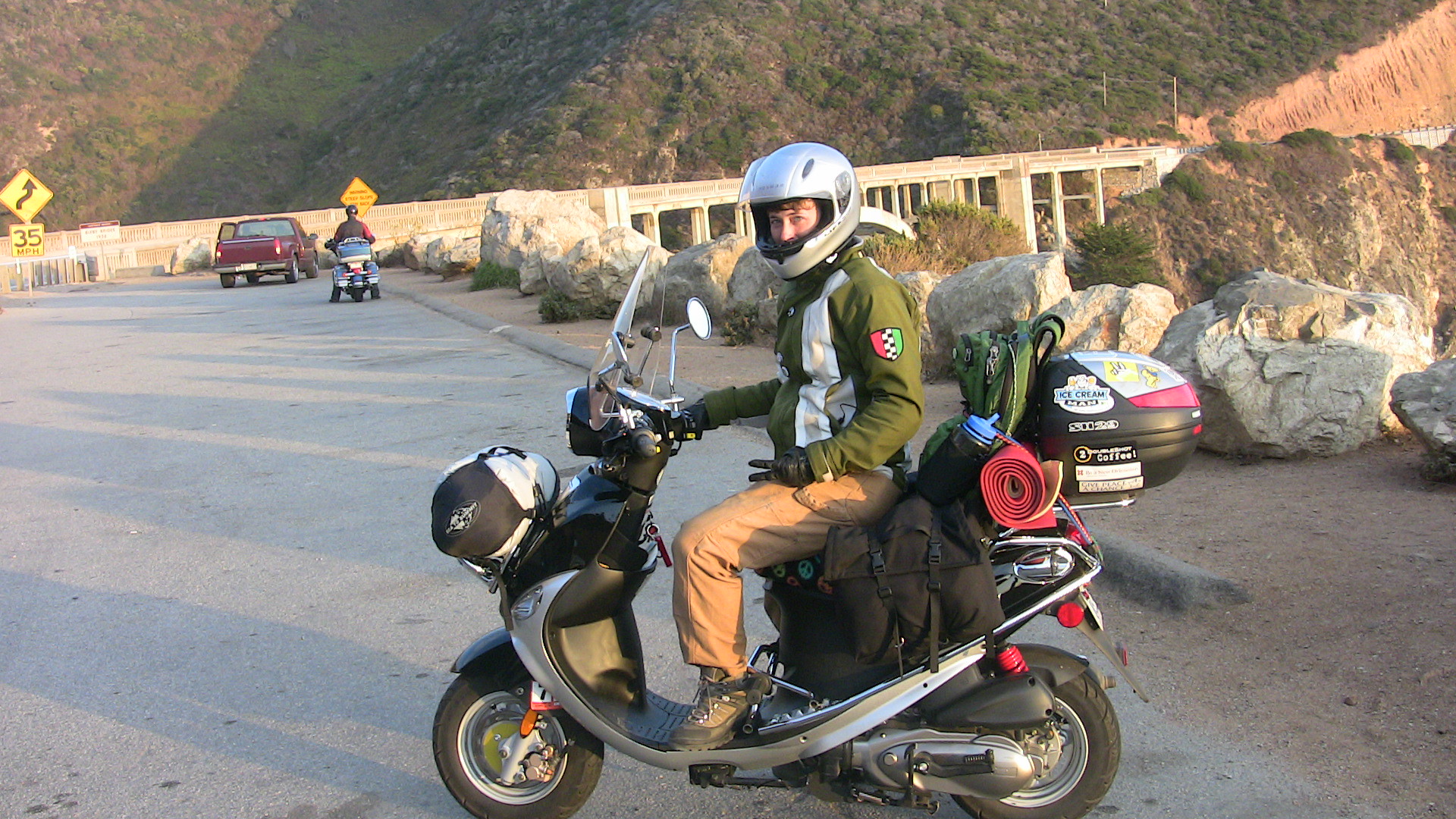This article was written in June 2020 for Scooter Zine. The publisher reached out to me for an interview, found out I was a journalist and asked me to write it myself.
Thirteen years ago, I wrangled gear onto a small motor scooter, started up the engine and vroomed off to create the largest peace sign in history.
My scooter, named Audre in honor of activist Audre Lorde, is a 125 cubic centimeter engine Genuine Buddy capable of steady travel around 55 mph – though I hit top speed at 72 mph.
Thirty miles was the longest distance I had traveled prior to this journey, and I was only bitten by the two-wheel travel bug two months earlier when I bought a 50 cc Honda Metropolitan. The route ahead would stretch coast to coast and north to south, through the backroads and byways of 32 U.S. states.
It took 189 days and approximately $1,000 in gasoline, but at the end my route traced a 22,000 mile peace sign onto the map. I was inspired by a quote I saw at the traveling art exhibit “Come Together†of Beatle John Lennon: “If a billion people were thinking about peace, there would be peace in the world.” I set out to ask people how they define peace, feeling that it must be more than merely the opposite of “war.â€

First, I traveled over 11,000 miles of the vertical “anchor†and two “branches†of the peace sign. Mostly two-lane roads with roasting summer asphalt led me from the White House in Washington, D.C. to New Orleans, over to Salina, Kansas, up to North Dakota, through Montana over to Seattle, down the West Coast, north east through the Southwest, back to Salina, and then down to Crawford, Texas, where President George W. Bush had his home.
After a winter break, I traced the country’s perimeter, traveling again through bayous and the Bible Belt in the south before opening the throttle west; battling dust devils, high winds and temperatures up to 106 degrees as the route paralleled the Mexico border. I rode 1,000 miles in four days through much of that dry, isolated stretch. The route had some backtracking along the west coast and northern border, then new terrain as I continued east through Minnesota, Wisconsin, Illinois, Indiana, Ohio, Pennsylvania, and ended back at the White House on Aug. 8, 2008. Coincidentally, my peace sign was finished on what was reportedly the 50th anniversary of the symbol’s creation.
I still receive queries from people asking how to pack for long scooter trips. I used Rev-Pack saddlebags, which were very roomy and waterproof but tedious to finagle as often as I took them off; a Shad case (that leaked a little in heavy rain) with foam inside for electronics; a tiny cooking stove and single-serve French press; and a compression sack on the front rack with a sleeping bag, pup tent and ground cover cut from painter’s plastic. A full Tourmaster rain suit was kept under the seat for quick access. Eventually I switched to Prima saddlebags, roomy but not as waterproof as I needed. The climate changed in the West, so I shipped and swapped some clothes as needed. I wore a Corazzo jacket, reinforced riding pants and an obnoxious orange vest for increased visibility.

I camped, stayed in hostels, cheap motels and in stranger’s homes through Couchsurfing.com and the scooterist network.
People always ask: “What was your favorite place?â€
Cities are cities, and they’re a lot of fun. Many of my favorite highlights come from the moments enroute to a destination. The distinct geography dividing the country: the rolling, green hills winding through Wisconsin and Minnesota, where it is common to spot a lawn Viking; the muggy horizons through the Great Plains where only the wheat waves; the thick fragrance of honeysuckle at night in the South; the sheer ruggedness of Montana; sunshiny days snaking along the Pacific Ocean on Route 101/Route 1; or the arid, clay landscapes of the Southwest — endless sky punctuated with dusty buttes or looming cacti. Huge landscapes made me understand just how tiny people really are.
Rolling into urban hubs like Seattle, Los Angeles, San Francisco, Austin, Tucson, Minneapolis, Chicago or New Orleans was always welcoming. Between those hubs, the miles stretch out. There are town names I can’t recall, places where you are an outsider from the moment you arrive. But when people see you on a little scooter in their Heartland towns, they are curious and mostly accepting. Even with different views – I asked them to define peace as many of their younger residents were off fighting in the war – but they talked and listened because I had come so far. They appreciated the sheer guts it takes to be that far from home, alone on 10-inch wheels.

The byways, routes, lanes, and country roads of America reflect a region’s culture, offering stories to the traveler that cannot be found on the interstates. Off the interstate’s spine clings all the familiar stuff, the big box stores and fast food joints. On the other roads there are roadside attractions, communities, and people who wave from their front porch.
The scenery in between destinations painted my travels, but the people and the moments sculpted my experiences.
Like eating sweet, frozen custard with Dave’s family on a summer evening after exploring Milwaukee. Riding in packs with cool scooter clubs all across the country. A different host each place, but always a meal, coffee, a tour and conversation. Joining community volunteers in food kitchens and packing disaster relief supplies. I was offered a husband and a job as a ranch hand in weather-beaten Circle, Montana, population 615, where after Audre broke down I waited two long days for FedEx to deliver parts. In Kansas, I met “Farmer John,†who helped me when I ran out of gas.
“This is how I’d want my daughter treated,†he told me. All over the country, I saw the best in people. I’m fortunate that many are still in my life in some way.
There were moments I definitely wondered what the hell I was doing. There were near misses, scooter breakdowns, ruined engines, and lots of navigation issues. At the time, I didn’t have a smartphone or a good GPS. I carried actual paper maps, wrote down directions ahead of the day’s ride and did a lot of turning around and rerouting. I called friends on occasion when I was lost, to help guide me out of some remote spots. As a woman traveling alone, I wore neutral colors to avoid unnecessary extra attention. Those are things that a female solo traveler has to consider, unfortunately. I certainly slept in more than one stranger’s house with a chair against the door handle — just in case.

P.E.A.C.E. Scooter certainly isn’t in my rearview. Quite often, travel books center around a person’s pilgrimage to set the soul right. I wasn’t trying to escape anything when I left my home in Charlottesville, Virginia on July 15, 2007. I didn’t think I needed anything, either, I just had a goal to elevate conversations around peace. But an adventure like that shapes you, or you’re doing it wrong.
Many of the core principles behind my trip have now become mainstream: deliberate community building, supporting independent retailers and local food suppliers, environmental awareness, and a focus on diversity, equity and oppressive systems. These ideas were built into the name of the ride: A Patriot’s Exhibition Advancing Community and Environmentalism. I used “patriot†– defined as a “person who vigorously supports their country and is prepared to defend it against enemies or detractors,†— because I know we can be our worst enemy. I spoke often about the idea of “pointing two fingers, not one,†or using peaceful methods to propel change instead of just pointing at what you don’t like.
Now we see activists flooding the streets with raised fists and marching for change. The chants “No Justice, No Peace,†sound through the nation as people demand accountability for recorded accounts of police brutality repeatedly unleashed on people of color. As I write this, communities everywhere have gathered for months to define what they need and make it clear that now is the time to meet those needs — to know justice, to know peace.
Working for peace didn’t end when I unpacked the saddlebags in 2008, though my work is different now. Putting myself in uncomfortable situations and having difficult conversations with total strangers led me to a career in journalism. Across America, I discovered there are so many stories to tell. Now I work as a college professor, helping young journalists to tell these important stories. Audre, who was stolen once but returned within 12 hours, needs her carburetor cleaned but I still love zooming around on my scoot. Although, these days you are much more likely to find me on my bicycle.
Though the internet isn’t always reliable, the largest human peace sign was formed in 2017 by approximately 15,000 people at the Glastonbury Festival in England; Guinness World Records wasn’t there to make it official.
Hundreds of people helped me “put†peace on the U.S. map.
Thank you to the scooter community that journeyed beyond their city limits to greet me out on the road, and to everyone who showed me their neighborhoods, read my posts, and provided food, beer, housing and great company. I had no idea the expanse and camaraderie of the scooterist network. And thank you to Genuine Scooter Company and Moto Richmond for all of the assistance, as well as to every mechanic who put in wrench time.
Many people showed me on my trip that peace simply can be rooting for and welcoming a stranger, and being willing to find common ground. Many people have shown me in these past few months what does actually happen when millions join the conversation and take action for change.
You can read more about the trip on in the 2007 blog and 2008 blog. You can leave your definition of peace here.


